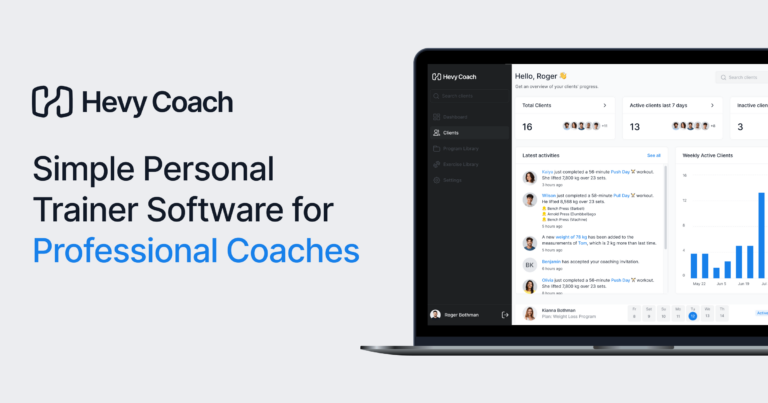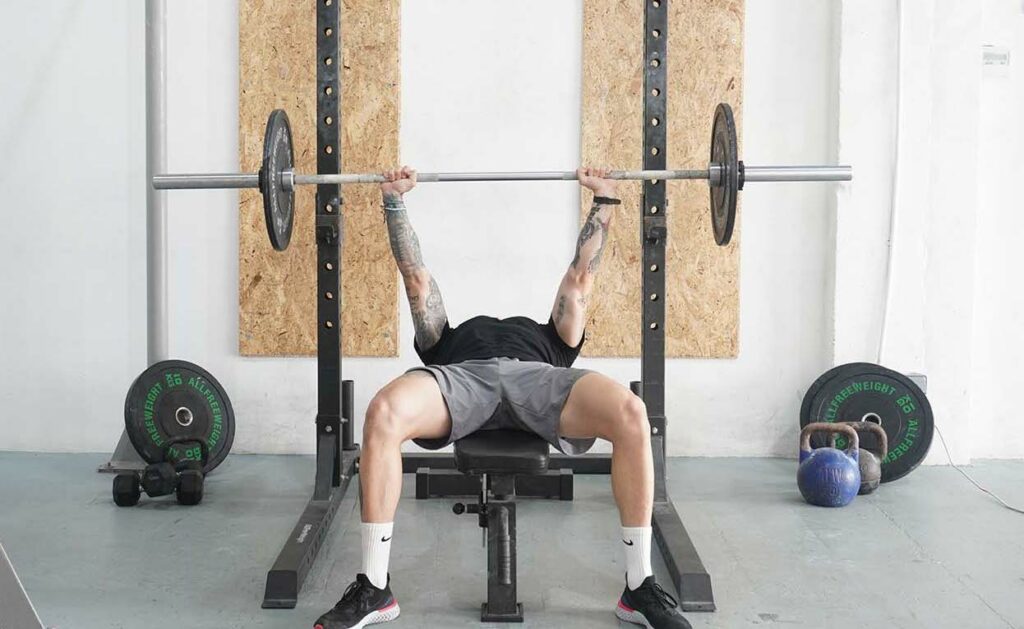Writing workout programs from scratch can be difficult and time-consuming, especially for a personal trainer or online coach with 10, 20, or 30+ regular clients.
However, you cannot just improvise and hope for the best because good programming is essential to getting your clients the desired results: muscle gain, strength development, etc.
Any average personal trainer can scribble a quick workout on a piece of paper, hand it to the client, and hope for the best. But it takes a great trainer to recognize that planning and periodizing one’s training approach is necessary for good progression and a low risk of overtraining.
So, what are you supposed to do? One option is working hours daily, writing programs, and making tweaks.
Alternatively, leverage workout templates to streamline the process.
What Are Workout Templates?
A template is a mold, form, or pattern used as a guide to making something. In the context of workout programs, a template is a simple document or spreadsheet that has some information and directions, making it easier to create a training program.
Instead of writing each new program from scratch, you consider which template works best for a specific client and use it as a guide to creating their training program. As a result, you can write programs that work without spending nearly as much time wondering about the details.
So, whether you’re running a personal training business, coaching people online, or working at a gym, read on to learn how to use personal training templates to elevate your practice.

Try Hevy Coach
Intuitive personal trainer software, with a world class experience for your clients.
30 day free trial, no credit card required
Also, check out Hevy Coach––a platform designed for coaches and personal trainers. It makes it easy to provide workout plans to each client, track their progress, communicate when necessary, and adjust their routines.
What Makes for Effective Program Design?
Before looking at some personal training workout templates, we must briefly examine some core components of effective program design.
1. It Aligns With the Trainee’s Goals
The first essential step is to ensure that you can use the template as a foundation for a training program that aligns with your client’s goals. You don’t want to end up with a workout plan that doesn’t help your client reach their goals.
You also don’t want to rework the entire template until you’ve created an effective plan for your client. For example, if you start with a bodybuilding template for a powerlifting client, you’re going to change everything until you have a solid plan, which defeats the purpose of a template.

2. It Prioritizes and Arranges Exercises Correctly
Arranging exercises in the correct order is crucial for optimal performance and the best possible training outcomes.
A good template should prioritize big compound lifts and include the accessory and isolation activities in the middle and near the end of each workout. Doing so is necessary for optimizing performance on the exercises with the biggest impact. Here’s what research suggests (1):
“Generally, with relevance to acute responses, a key finding was that exercise order affects repetition performance over multiple sets, indicating that the total repetitions, and thus the volume, is greater when an exercise is placed at the beginning of an RT session, regardless of the relative amount of muscle mass involved.”
And:
“When prescribed appropriately with other key prescriptive variables (i.e., load, volume, rest interval between sets and exercises), the exercise order can influence the efficiency, safety and ultimate effectiveness of an RT programme.”
3. It Considers Loading and the Correct Repetition Range
Some exercises are more suited for heavy training and low-rep sets, whereas others work best when trainees lift light weights for 12, 15, or 20 reps.
For example, you can do 20-rep deadlifts, but the potential reward is not worth the risks like extreme fatigue, technique breakdown, and soreness in the following days.
Similarly, you can do heavy, 6-rep sets of lateral raises, but that would also not be ideal because you couldn’t isolate the deltoids effectively. Instead, you would have to use multiple other muscles to hoist the dumbbells to the top position.
Because of these fundamental rules, a good template assigns the correct repetition range to each movement.
4. It Combines a Variety of Stressors
A good training program includes exercises that stress the body in multiple ways, providing mechanical tension and metabolic stress for hypertrophy and strength gains (2, 3).
Put simply:
- It should include at least two exercises per muscle group (e.g., a horizontal and vertical pull for the back)
- It should mix two or more rep ranges, depending on the movements and the trainee’s goals
- It should mix compound (multi-joint) and isolation (single-joint) exercises
- It should encourage trainees to use different tempos for a more varied training stimulus: slow eccentrics, explosive reps, pause reps, etc.
5. It Becomes Increasingly Challenging to Meet the Trainee’s Needs
Even the best training program will eventually cease to be effective. Clients adapt to the training stress and struggle to see new improvements unless their workout programs become more challenging (4).
A good template needs to account for your client’s needs, allowing you to produce workout programs that are challenging enough but not to the point where they lead to overtraining.
In addition, you must consider your client’s progression over the weeks and provide guidelines for how and when to increase the difficulty.
6. It Provides Some Flexibility
A common mistake coaches make when training clients is providing rigid workout programs that don’t allow flexibility. For example, the second exercise in the workout is a lat pulldown, and that’s non-negotiable.
But what if your client goes to another gym that doesn’t have a lat pulldown machine, or the one they typically use isn’t available?
Or perhaps it has nothing to do with equipment. Maybe a specific exercise you’ve prescribed is causing some nagging pain or discomfort. Should your client still stick with that movement, even if it puts them at risk of an injury?
Of course not. For these and other reasons, your clients should have some freedom to make adjustments during their training. One option is to provide some potential exercise alternatives, which your clients can use as quick swaps during their workouts.
However, workout programs shouldn’t be too flexible. If they are, the client can change the entire plan to the point where you can’t even recognize it.
How to Classify Exercises (And Why That Matters For a Workout Template)
Putting together a list of the most popular exercises and labeling them is a great way to plug and play when personalizing a program or making tweaks to an existing routine.
One option is to have a spreadsheet that lists many exercises for all major muscle groups, broken down by type, purpose, and priority. Use Excel or Google Sheets.

In strength training, you can classify exercises as:
- Primary – these are the compound exercises that should make up the bulk of the client’s training program. Examples include squats, bench press variations, deadlifts, and rows.
- Secondary – these are assistance exercises that complement the primary lifts. Some examples include one-arm dumbbell rows, leg presses, and seated dumbbell shoulder presses.
- Isolation – these are the single-joint exercises trainees should do near the end of their workouts to focus on a single muscle group. Prominent examples include bicep curls, tricep extensions, hamstring curls, and calf raises.

Try Hevy Coach
Intuitive personal trainer software, with a world class experience for your clients.
30 day free trial, no credit card required
Here is how you might organize these in a spreadsheet, with an example of one movement per muscle group and category:
| Muscle Group | Primary | Secondary | Isolation |
| Chest | Flat barbell bench press | Incline dumbbell bench press | High cable crossover fly |
| Back | Pull-up | One-arm dumbbell row | Cable lat pullover (not truly isolation, but close) |
| Quadriceps | High-bar back squat | Leg press | Leg extension |
| Glutes | Hip thrust | Bulgarian split squat | Quadruped donkey kicks |
| Shoulders | Standing barbell overhead press | Seated dumbbell shoulder press | Dumbbell lateral raise |
| Biceps | Chin-up | Barbell row | Dumbbell bicep curl |
| Triceps | Close-grip bench press | Bench dips | Cable rope tricep extension |
| Hamstrings | Romanian deadlift | Glute bridge | Lying hamstring curl |
| Calves | – | – | Standing machine calf raises |
As you can see, classifying exercises isn’t always easy. For example, how would you compare a Romanian deadlift to a single-leg deadlift? Would the former be a primary exercise and the latter a secondary lift? If so – why?
Don’t get too bogged down on the details. When wondering how to classify a movement, consider its overall impact:
- How good is the overloading potential?
- How many muscle groups does the exercise train?
- How much fatigue does it generate?
For example, deadlifts are clearly a primary exercise because of their tremendous overloading potential, ability to train the entire body, and the fatigue they generate. Therefore, it’s best to include them early in a workout and have clients lift as much weight as possible with proper form for fewer reps.
Also, you don’t have to make your spreadsheet in the same way. The above is just an example of how you might do it. You can also classify exercises based on movement patterns (e.g., horizontal press), benefits (e.g., great for strength), etc.
Rep Ranges and Set Recommendations
The following recommendations will apply to most trainees in most situations. Of course, there are always exceptions, so use your best judgment.
- Primary exercises – 5 to 10 reps per set; 3 to 5 sets per movement
- Secondary exercises – 8 to 15 reps per set; 2 to 4 sets per movement
- Isolation exercises – 12 to 25+ reps per set; 2 to 4 sets per movement
Free Personal Training Templates For the Upper and Lower Body
Template 1 (Intermediate, hypertrophy-focused)
| 4-Day Upper/Lower | |
| Monday | Upper A |
| Tuesday | Lower A |
| Wednesday | Off |
| Thursday | Upper B |
| Friday | Lower B |
| Saturday & Sunday | Off |
| Upper A | Lower A | Upper B | Lower B |
| Chest (primary) – 3 to 4 sets | Quadriceps (primary) – 3 to 4 sets | Back (primary) – 3 to 4 sets | Glutes (primary) – 3 to 4 sets |
| Back (primary) – 3 to 4 sets | Quadriceps (secondary) – 2 to 4 sets | Shoulders (primary) – 3 to 4 sets | Hamstrings (primary) – 3 to 4 sets |
| Shoulders (secondary) – 2 to 4 sets | Hamstrings (secondary) – 2 to 3 sets | Chest (secondary) – 2 to 3 sets | Quadriceps (secondary or isolation) – 2 to 3 sets |
| Biceps (isolation) – 2 to 3 sets | Calves (isolation) – 3 to 4 sets | Biceps (isolation) – 2 to 3 sets | Calves (isolation) – 3 to 4 sets |
| Triceps (isolation) – 2 to 3 sets | Triceps (isolation) – 2 to 3 sets |
Template 2 (Beginner, no specific focus)
| 3-Day Full Body | |
| Monday | Full Body A |
| Tuesday | Off |
| Wednesday | Full Body B |
| Thursday | Off |
| Friday | Full Body C |
| Saturday & Sunday | Off |
| Full Body A | Full Body B | Full Body C |
| Quadriceps (primary) – 3 to 4 sets | Back (primary) – 3 to 4 sets | Chest (primary) – 3 to 4 sets |
| Chest (primary) – 3 to 4 sets | Hamstrings (primary) – 3 to 4 sets | Shoulders (primary) – 3 to 4 sets |
| Back (secondary) – 3 sets | Chest (secondary) – 2 to 3 sets | Quadriceps (secondary) – 2 to 4 sets |
| Shoulders (secondary) – 2 to 3 sets | Shoulders (isolation) – 2 to 3 sets | Back (secondary) – 2 to 4 sets |
| Biceps (isolation) – 2 to 3 sets | Triceps (isolation) – 2 to 3 sets | Hamstrings (isolation) – 2 to 4 sets |
Template 3 (Advanced, hypertrophy-focus)
| 6-Day Push/Pull/Legs | |
| Monday | Push A |
| Tuesday | Pull A |
| Wednesday | Legs A |
| Thursday | Push B |
| Friday | Pull B |
| Saturday | Legs B |
| Sunday | Off |
| Push A | Pull A | Legs A | Push B | Pull B | Legs B |
| Chest (primary) – 3 to 4 sets | Back (primary) – 3 to 4 sets | Quadriceps (primary) – 3 to 4 sets | Shoulders (primary) – 3 to 4 sets | Back (primary) – 3 to 4 sets | Glutes (primary) – 3 to 4 sets |
| Shoulders (secondary) – 3 to 4 sets | Back (primary) – 3 to 4 sets | Hamstrings (primary) – 3 to 4 sets | Triceps (primary) – 3 to 4 sets | Back (primary) – 3 to 4 sets | Hamstrings (primary) – 3 to 4 sets |
| Triceps (secondary) – 2 to 4 sets | Back (secondary) – 3 to 4 sets | Quadriceps (secondary) – 3 to 4 sets | Chest (secondary) – 3 to 4 sets | Back (secondary) – 3 to 4 sets | Quadriceps (secondary) – 3 to 4 sets |
| Chest (isolation) – 2 to 4 sets | Back (secondary) – 3 to 4 sets | Hamstrings (secondary) – 3 to 4 sets | Shoulders (isolation) – 2 to 4 sets | Back (secondary) – 3 to 4 sets | Glutes (secondary) – 3 to 4 sets |
| Shoulders (isolation) – 2 to 4 sets | Biceps (isolation) – 2 to 4 sets | Calves (isolation) – 3 to 4 sets | Triceps (isolation) – 2 to 4 sets | Biceps (isolation) – 2 to 4 sets | Hamstrings (isolation; optional) – 2 to 4 sets |
| Triceps (isolation; optional) – 2 to 4 sets | Biceps (isolation) – 2 to 4 sets | Chest (isolation) – 2 to 4 sets | Biceps (isolation) – 2 to 4 sets | Calves (isolation) – 2 to 4 sets |
A Few Words On The Templates From Above
The first and most important thing to remember is that templates can serve as the foundation of a training plan. However, that doesn’t mean you should always follow the model down to a T.
As a trainer, your job is to find the best way to organize each client’s training plan based on their unique needs and desires. Additionally, don’t be afraid to offer ideas for exercise swaps or give your clients some freedom to make changes when necessary.
Putting together a list of primary, secondary, and isolation exercises is beneficial because it allows you to group similar activities and provide alternatives, should your clients need them.
Aside from that, when assigning training volume, approach it with the mindset of “Less is more.” Personal trainers often assign many sets to each exercise, which is usually unnecessary for optimal results.
Begin with less training volume and emphasize the importance of effort and proper technique to help your clients get more out of every rep, set, and exercise they perform. Only increase the overall volume when clients feel rested but aren’t making good strength or hypertrophy progress.

Try Hevy Coach
Intuitive personal trainer software, with a world class experience for your clients.
30 day free trial, no credit card required
Final Words
Personal training templates are an invaluable tool coaches can use to write effective workout plans more quickly without starting from scratch each time.
A good template covers several things, including trainees’ goals, proper exercise order, and rep ranges for different movement types.
Plus, the beauty of workout templates is that you can export them on all your devices, including an iPad or Android tablet, and use them as a foundation for every strength training program you write.
Check out Hevy Coach if you’re interested in other ways to improve as a personal trainer. The platform makes it easy to keep all your clients in one place, track how each is doing, provide workout plans, make adjustments, and communicate.




